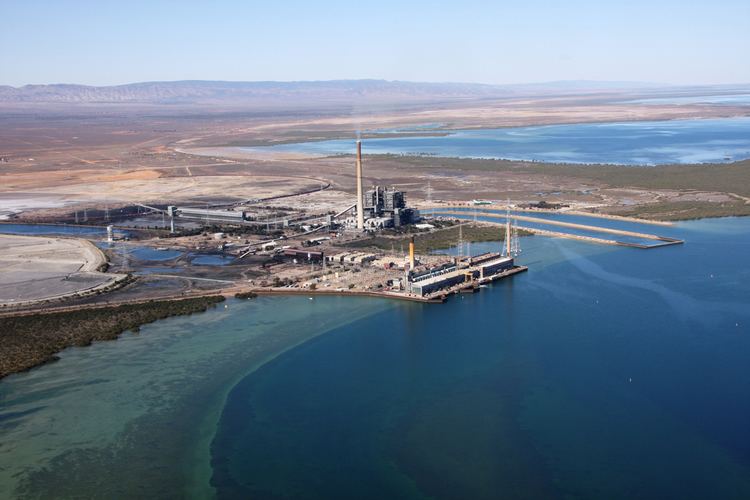Country Australia Units operational 2 | Commission date 1985 Operator Alinta | |
 | ||
Location | ||
Northern Power Station is located in the locality of Port Paterson in the Australian state of South Australia about 6 kilometres (3.7 mi) south of the city centre of Port Augusta. It was coal powered with two 260 MW steam turbines that generated a total of 520 MW of electricity. It was operated and maintained by Alinta Energy and was commissioned in 1985. Northern received coal by rail from the Leigh Creek Coal Mine, 280 km to the north. The plant ceased electricity production in May 2016 and decommissioning is underway.
Contents
Air
Carbon Monitoring for Action estimated that this power station emitted 3.62 million tonnes of greenhouse gases each year as a result of burning coal. Other air-borne emissions were reported annually to the National Pollution Inventory. As of 2012-13, from greatest to smallest quantity, airborne emissions included: sulfur dioxide, oxides of nitrogen, hydrochloric acid, particulate matter, carbon monoxide, volatile organic compounds, manganese, mercury, chromium, boron, chlorine, zinc, nickel, copper, lead and others.
Marine
Northern Power Station drew cooling water from Upper Spencer Gulf and returned it to the sea at an elevated temperature. The water was returned 7 °C warmer than the original intake water. The flow rate was 47 m³ per second. Its outfall channel is intended to be used by Sundrop Farms to disperse desalination brine from a proposed seawater desalination plant to create freshwater for a greenhouse, expected to be completed in 2016.
Additional marine emissions included (from largest to smallest quantities): boron, fluoride, arsenic, manganese, chromium, nickel and mercury.
Closure and alternative uses
Despite being the lowest marginal cost fossil fuel generator in South Australia, Northern's economic viability was progressively eroded as wind and solar generation increased in South Australia. During the operation of carbon pricing in Australia under the Clean Energy Act, Northern reduced operation to seasonal summer-only operation.
In recent years its long-term future has been subject to much consideration, including life extension and complete replacement. In 2013, Alinta Energy announced that it was investigating developing a new low-grade coal deposit which could extend the working lives of both Northern and adjacent Playford B power stations until the year 2030. Concept level proposals have been discussed for the replacement of the plant with either a gas-fired, a concentrated solar thermal plant or a nuclear power plant.
On 11 June 2015, Alinta Energy announced its intent to permanently close the power station by March 2018, along with the related Playford B Power Station, and the Leigh Creek coal mine that supplies them both with fuel. This was updated on 30 July 2015 to bring the closure dates of all three facilities forward by 12 months, with closure to occur between March 2016 and March 2017.
On 7 October 2015, Alinta Energy announced that Northern and Playford B would close around 31 March 2016. Alinta Energy shut off the Northern Power Station at about 9:30am on 9 May 2016.
Months after the shutdown, the state was plunged into darkness with some parts losing power for days — after a mid-latitude cyclone smashed through SA in late September 2016, damaging vital infrastructure. Federal Resources Minister Matt Canavan said large energy users and interstate power operators had discussed the reopening of the Northern Power Station but this has been dismissed by the South Australian Government.
Fly ash playa and health concerns
With the permanent closure of the Playford B and Northern power stations at Port Augusta, dampening flows of water across the adjacent fly ash playa ceased. This allowed the fly ash, which contains crystalline silica, to become airborne. On several occasions in 2016 and 2017, plumes of the fine grey fly ash powder became visible rising from power station site and blew into the town of Port Augusta, concerning residents and impacting air quality.
In February 2017, topsoil application trials were underway and liquid odour suppressant was being applied periodically to the flyash dam.
